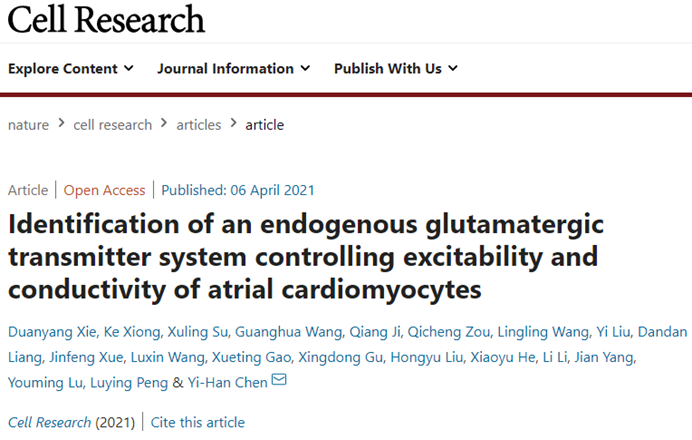Academician CHEN Yihan’s team discovers that atrial cardiomyocytes and sinoatrial node pacemaker cells have an endogenous glutamate transmitter system, which acts in atrial cardiomyocytes in an excitation and conduction pattern similar to brain glutamatergic neurons. It functions as an inherent module of pacemaker cells and significantly regulates cardiac pacing activity and heart rate.

In research on atrial cardiomyocytes, CHEN Yihan’s team found: as an excitatory transmitter system, the glutamatergic transmitter system controls excitability and conductivity of neurons. Since both cardiomyocytes and neurons are excitable cells, they hypothesized that cardiomyocytes may also be regulated by a similar system. They have demonstrated that atrial cardiomyocytes have an intrinsic glutamatergic transmitter system, which regulates the generation and propagation of action potentials. First, there are abundant vesicles containing glutamate beneath the plasma membrane of rat atrial cardiomyocytes. Second, rat atrial cardiomyocytes express key elements of the glutamatergic transmitter system, such as the glutamate metabolic enzyme, ionotropic glutamate receptors (iGluRs), and glutamate transporters. Third, iGluR agonists evoke iGluR-gated currents and decrease the threshold of electrical excitability in rat atrial cardiomyocytes. Fourth, iGluR antagonists strikingly attenuate the conduction velocity of electrical impulses in rat atrial myocardium both in vitro and in vivo.Knockdown of GRIA3 or GRIN1, two highly expressed iGluR subtypes in atria, drastically decreased the excitatory firing rate and slowed down the electrical conduction velocity in cultured human induced pluripotent stem cell (iPSC)-derived atrial cardiomyocyte monolayers. Finally, iGluR antagonists effectively prevent and terminate atrial fibrillation in a rat isolated heart model. In addition, the key elements of the glutamatergic transmitter system are also present and show electrophysiological functions in human atrial cardiomyocytes. In conclusion, their data reveal an intrinsic glutamatergic transmitter system directly modulating excitability and conductivity of atrial cardiomyocytes through controlling iGluR-gated currents. Manipulation of this system may open potential new avenues for therapeutic intervention of cardiac arrhythmias.
In the research on the pacemaker cells of the sinus node, the team of Academician Chen Yihan found that the pacemaker cells are similar to glutamatergic neurons in the cerebral cortex. They found that, whether in embryonic or adult stage, pacemaker cells have the cellular properties and characteristic molecular elements of this type of neuron. Their research proved that the pacemaker cells themselves have an independent and complete glutamate transmitter system, and interventions for the glutamate transmitter system (such as glutamate receptors or transporters) can significantly change the heart rate. As we all know, the traditional concept believes that sympathetic nerves and parasympathetic nerves critically regulate heart rate, but they belong to the heart's external regulatory system. This study reveals that the glutamate transmitter system acts as the heart's endogenous heart rate regulation module. This discovery has potential significance for the prevention and treatment of arrhythmias, especially bradycardia or tachycardia caused by defects in pacemaker cells. The magazine issued a review during the same period. They believe that their research defines the new cellular properties of pacemaker cells for the first time, brings new strategies for the prevention and treatment of arrhythmia, represents a conceptual breakthrough in the field, and opens a research direction.
The above research results were published online on April 6th and February 6th respectively in the international authoritative journal Cell Research (The corresponding author is Academician CHEN Yihan, Tongji University School of Medicine and Affiliated Oriental Hospital, and the first author is XIE Duanyang, researcher of Tongji University School of Medicine and Affiliated Oriental Hospital, etc.) and Protein & Cell (corresponding author is Academician CHEN Yihan and the first author is LIANG Dandan, researcher of Tongji University School of Medicine and Affiliated Oriental Hospital, etc.).
Original links:
